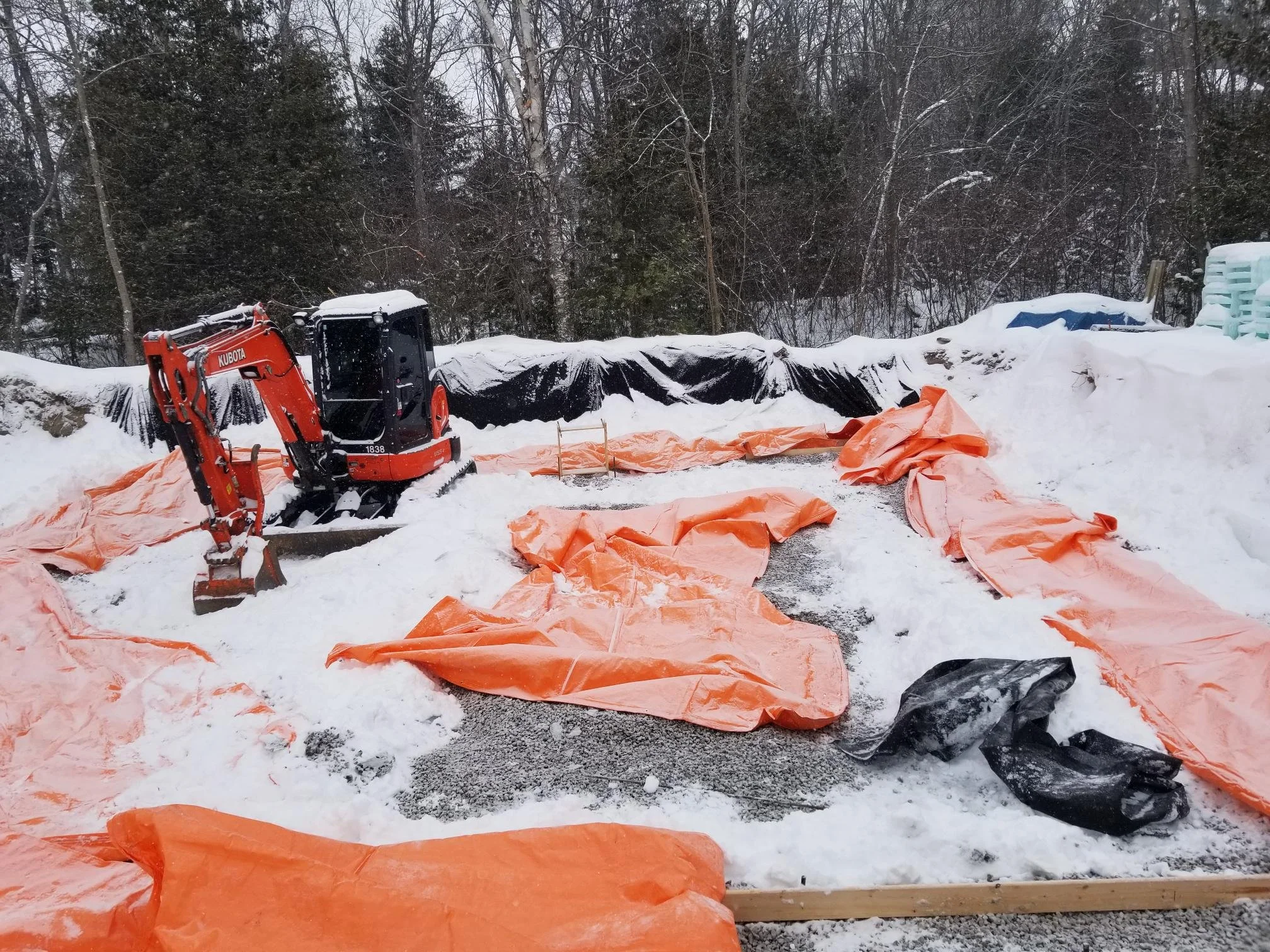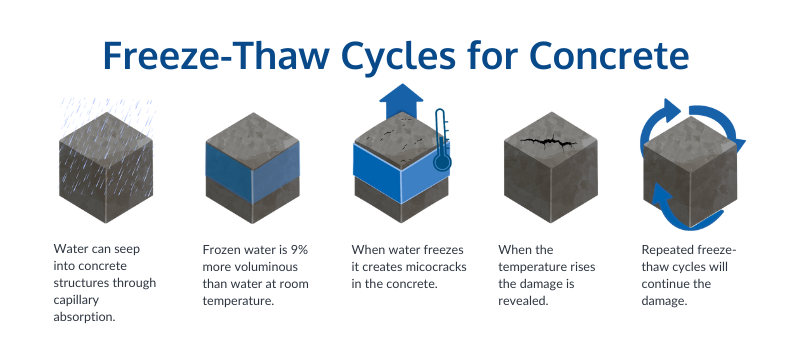Mastering Concrete Placement in Cold Climates
Concrete is a powerhouse material—strong, versatile, and essential to countless construction projects. But when temperatures drop, working with concrete requires careful planning and specialized techniques. At PRI Engineering, we understand the challenges of cold weather concrete placement and know how to mitigate the risks. From understanding the science behind hydration to implementing effective curing strategies, this guide will help you achieve strong, durable results in cold climates.
Footing formwork covered in preparation to place concrete at Ripple St. Fenelon Falls. The insulated tarps are placed over the subgrade to mitigate frost penetration
Why Cold Weather Challenges Concrete Strength
Concrete gains its strength through hydration, a chemical reaction between cementitious material and water. However, cold temperatures slow down this reaction, delaying setting and curing times. If the concrete freezes during the first 72 hours, the water inside expands, causing cracks and structural weaknesses before the concrete has a chance to gain strength.
At 5°C, concrete takes twice as long to set compared to 20°C. Below 0°C, hydration stops completely, leaving the concrete vulnerable. Understanding these dynamics allows for proactive measures to protect fresh concrete, ensuring a long-lasting, high-performance structure, particularly during the initial 72 hours of curing.
Best Practices for Cold Weather Concrete Placing
When working with concrete in cold conditions, preparation and execution are critical. Below are key considerations for ensuring success:
Keep Subgrades Warm and Stable
Placing concrete on frozen ground can cause instability as the subgrade thaws and refreezes and also can limit the ability to maintain the concrete temperature above 5oC during the critical initial 72 hours of curing. Preheating the subgrade and keeping it above freezing ensures a stable foundation and maintains the durability of the concrete material.
Monitor and Prepare Granular Materials
Frozen granular materials compromise compaction, leading to uneven settlement. Thaw and properly compact these materials before placing concrete on an approved subgrade layer.
Use Heated Enclosures & Insulated Blankets
Covering freshly placed concrete with insulated blankets or using heated enclosures helps maintain the necessary warmth for proper curing.
Choose Cold Weather Admixtures
Adding accelerators can speed up hydration, reducing the risk of freezing. Air-entraining admixtures improve freeze-thaw resistance.
Prevent Rapid Cooling After Finishing
Even after initial setting, concrete needs gradual cooling to avoid thermal shock and uniform curing, since hydration rates can be a function of the temperature, with hydration occurring more readily in hot conditions. Remove insulation gradually to prevent cracking.
Avoiding Common Pitfalls in Cold Weather Concrete Projects
Even with careful planning, cold weather concreting comes with challenges. Avoid these common mistakes:
Skipping Protection: Failing to insulate or protect fresh concrete can lead to surface cracking and weak structures, due to the development of tensile cracks from uneven curing (core hydrates quicker than the surface resulting in different shrinking rates). Concrete shrinks when it cures. If it shrinks at different rates this is called plastic shrinkage.
Pouring on Frozen Ground: Frozen subgrades disrupt curing and cause long-term instability. Thaw the ground using heaters or insulated covers before placing.
Overlooking Temperature Monitoring: Use sensors to track curing temperatures in real time. If freezing is detected, immediate corrective actions can prevent failure or further damage.
Rushing the Curing Process: Cold weather requires extended curing times. Insulation and patience ensure concrete reaches its design strength.
Cold Weather Monitoring Program: Kent Street Case Study
Our work on Kent Street showcases how proactive cold weather strategies lead to success, even in challenging conditions.
From March to April 2021, PRI Engineering implemented a cold weather monitoring program for curb placements, ensuring concrete met required strength levels. Key steps included:
Subgrade Preparation: Excavations were preheated to at least 5°C for 12 hours before placement. Tarps and insulated blankets were used to retain heat and prevent refreezing before concrete placement.
Granular Inspections: Ensured all granular materials were thawed and compacted to prevent settlement issues.
Temperature Monitoring: Sensors recorded curing temperatures every 15 minutes to track progress and ensure optimal conditions. Heating blankets were applied to the surface to maintain adequate curing temperatures, especially in extreme cold.
A Bump in the Road: The Impact of Insufficient Protection
During the concrete placement process, maintaining consistent curing temperatures is critical to preventing thermal shock and surface defects.
A strong gust of wind from the west led to rapid cooling of the curb surface, causing the concrete to contract unevenly and resulting in premature cracking. Without adequate insulation or wind barriers, the surface was unable to retain the necessary heat for proper curing. As a result, the affected curb section had to be completely removed and replaced, leading to delays and increased material costs.
This setback reinforced the importance of comprehensive protection strategies, including the use of insulated tarps, windbreaks, and heating blankets. By implementing these measures consistently, the risk of temperature-related defects can be significantly reduced, ensuring durable and high-quality concrete placements in cold climates.
Why Is Freshly Placed Concrete Covered with Plastic?
Covering freshly placed concrete with plastic is a common practice that plays a crucial role in the curing process. Here’s why it’s essential:
Moisture Retention – Plastic sheeting prevents excessive water evaporation, ensuring the concrete stays properly hydrated for optimal strength development.
Crack Prevention – By maintaining moisture levels, plastic reduces shrinkage, helping to prevent surface cracks and premature weakening.
Temperature Regulation – A plastic cover helps maintain a stable curing temperature, which is especially important in fluctuating weather conditions.
Protection from Contaminants – The covering shields the concrete from dust, debris, and rain, preserving its finish and integrity.
Using plastic sheeting is a simple yet effective way to enhance the durability and performance of concrete, especially in challenging environments.
Results That Speak for Themselves
Within seven days, both laboratory and field-cured specimens met 75% of the design compressive strength. Field-cured samples closely matched lab results, demonstrating the effectiveness of our cold weather strategies.
What We Learned
Preparation is Non-Negotiable: Preheating and thorough inspections are crucial.
Data Drives Success: Continuous monitoring allows for real-time adjustments.
Cold Weather Techniques Work: With the right approach, frigid temperatures won’t compromise quality.
Conclusion
Cold weather doesn’t have to slow your project down. With the right strategies, you can ensure your concrete is strong, durable, and built to last—no matter the season. At PRI Engineering, we combine technical expertise with a commitment to quality, ensuring your construction projects succeed in even the harshest conditions.
Let’s make your next project a success, even when temperatures drop. Contact PRI Engineering today to discuss cold weather concreting solutions tailored to your needs.







